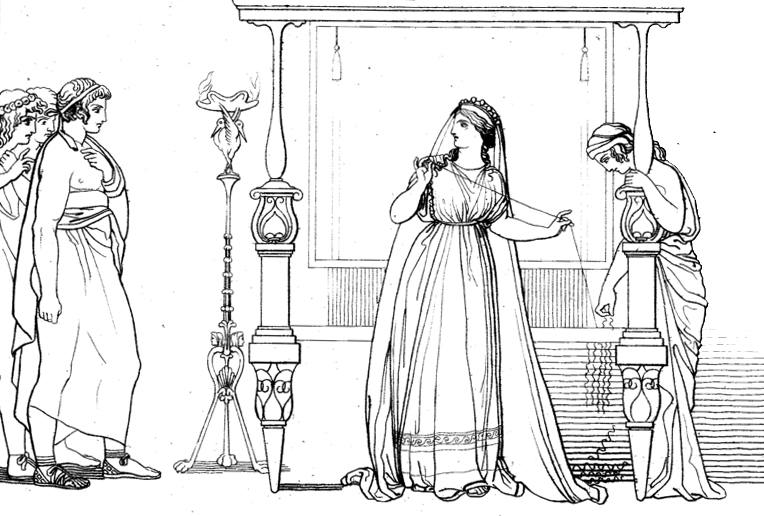Images of Daily Life
 In both Greek and Roman cultures, most women spent their days raising children, preparing food, and making clothing. Certainly exceptions did exist: women in poorer families would likely have left home to help their husbands in the fields, and there are even records of women owning their own businesses. Although some enjoyed the benefit of education and the leisure of privilege, women were required to uphold the idealized roles that a patriarchal society had allotted them. In Homer’s Odyssey, for example, Penelope’s fidelity is symbolized by her diligent weaving, day after day, year after year, until her husband’s return. Similarly, Roman tomb inscriptions often employ the epithet lanam fecit (“she wove wool”) as a formula for female faithfulness.
In both Greek and Roman cultures, most women spent their days raising children, preparing food, and making clothing. Certainly exceptions did exist: women in poorer families would likely have left home to help their husbands in the fields, and there are even records of women owning their own businesses. Although some enjoyed the benefit of education and the leisure of privilege, women were required to uphold the idealized roles that a patriarchal society had allotted them. In Homer’s Odyssey, for example, Penelope’s fidelity is symbolized by her diligent weaving, day after day, year after year, until her husband’s return. Similarly, Roman tomb inscriptions often employ the epithet lanam fecit (“she wove wool”) as a formula for female faithfulness.
Objects featuring domestic scenes were frequently presented as wedding gifts and served as household furnishings that reinforced the centrality of family life. On vases and frescoes, women stand or sit in an interior and engage in spinning, weaving, or other domestic activities. While previously rare in Greek art, the frequency of such scenes expanded around 530 BCE with the invention of the red-figure technique on Athenian vases. Illustrations were created with brushstrokes rather than by incisions made into the clay, allowing artists to depict figures in more naturalistic poses with greater attention to the details of appearance and even of facial expression. By the early fifth century, scenes of daily life, focusing largely on male activities like warfare, athletics, and drinking symposia, had become popular. By the middle of the fifth century, vases began to depict the more intimate world of women as well.
One can see poignant moments illustrating the bonds of home and family: women preparing a bride for her wedding, bidding goodbye to a departing warrior, or performing rituals for the dead at a tomb.
Image credit: John Flaxman (British, 1755-1826), The suitors discover Penelope's ruise (illustration for The Odyssey), 1810. Photograph courtesy of Wikimedia Commons.
Penelope awaits the return of her husband, Odysseus, while under siege by her suitors. She stalls their advances by weaving her father-in-law’s funeral shroud by day and unraveling it by night, promising to remarry upon its completion.

 Earlier
Earlier Earlier
Earlier




